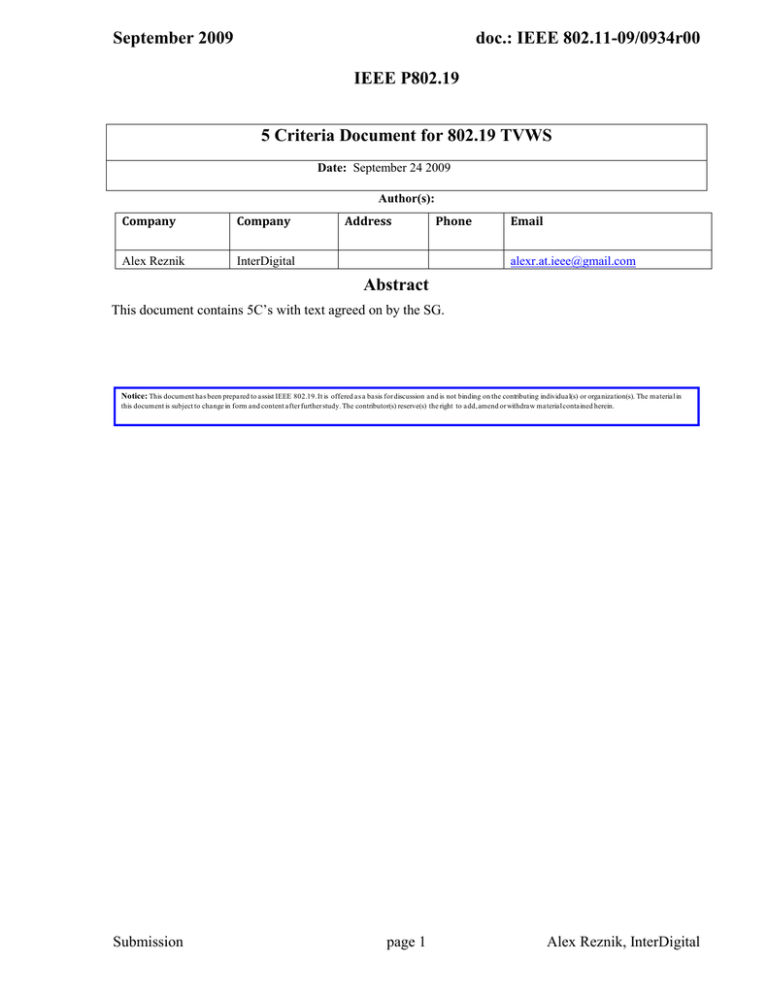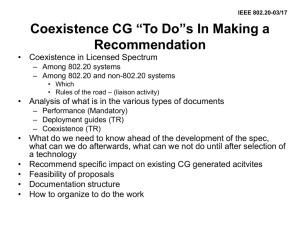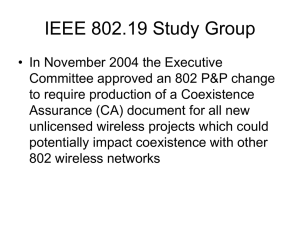September 2009 doc.: IEEE 802.11-09/0934r00 IEEE P802.19
advertisement

September 2009 doc.: IEEE 802.11-09/0934r00 IEEE P802.19 5 Criteria Document for 802.19 TVWS Date: September 24 2009 Author(s): Company Company Alex Reznik InterDigital Address Phone Email alexr.at.ieee@gmail.com Abstract This document contains 5C’s with text agreed on by the SG. Notice: This document has been prepared to assist IEEE 802.19. It is offered as a basis for discussion and is not binding on the contributing individual(s) or organization(s). The material in this document is subject to change in form and content after further study. The contributor(s) reserve(s) the right to add, amend or withdraw material contained herein. Submission page 1 Alex Reznik, InterDigital September 2009 doc.: IEEE 802.11-09/0934r00 Five Criteria 17.5.1 Broad Market Potential A standards project authorized by IEEE 802 shall have a broad market potential. Specifically, it shall have the potential for: a) Broad sets of applicability. The need for a coexistence standard is demonstrated by the past and ongoing work in IEEE 802.11, IEEE 802.22, IEEE 802 ECSG on TVWS and the IEEE 802.19 TVWS SG as well as new TVWS PARs. b) Multiple vendors and numerous users. Current wireless ISP services use the 900MHz, 2.45 GHz and 5GHZ bands, operating under part 15 rules using multiple and dissimilar MAC/PHY standards or air interfaces. There are many vendors of IEEE 802 wireless equipment for indoor and outdoor operation, and it is expected that there will be several offering equipment for the TVWS band. c) Balanced costs (LAN versus attached stations). Current technology enables manufacturers to balance costs for coexistence mechanisms. 17.5.2 Compatibility IEEE 802 defines a family of standards. All standards shall be in conformance with the IEEE 802.1 Architecture, Management, and Interworking documents as follows: 802. Overview and Architecture, 802.1D, 802.1Q, and parts of 802.1f. If any variances in conformance emerge, they shall be thoroughly disclosed and reviewed with 802. Each standard in the IEEE 802 family of standards shall include a definition of managed objects that are compatible with systems management standards. This standard will not require changes to any existing 802 MAC SAP definitions, ensuring that all LLC and MAC interfaces are compatible to and in conformance with the IEEE 802.1 architecture, management and internetworking standards. 17.5.3 Distinct Identity Each IEEE 802 standard shall have a distinct identity. To achieve this, each authorized project shall be: a) Substantially different from other IEEE 802 standards. There is no other standard among IEEE 802 standards, which specifies mechanisms for coexistence among dissimilar wireless networks operating in the TV White Space Bands. b) One unique solution per problem (not two solutions to a problem). Submission page 2 Alex Reznik, InterDigital September 2009 doc.: IEEE 802.11-09/0934r00 There is no other standard which specifies mechanisms for collaborative coexistence among dissimilar wireless networks operating in the TV White Space Bands. c) Easy for the document reader to select the relevant specification. The project will explain clearly its purpose and scope in the introduction section. 17.5.4 Technical Feasibility For a project to be authorized, it shall be able to show its technical feasibility. At a minimum, the proposed project shall show: a) Demonstrated system feasibility. Within the IEEE 802.19 TV White Space Study Group there have been a number of contributions indicating a number of technically feasible solutions. These contributions include multiple presentations to the 802.19 TVWS SG as available on Mentor <PUT LINK HERE>. b) Proven technology, reasonable testing. Extensive existing knowledge of coexistence techniques will be applied to develop the TVWS coexistence standard. c) Confidence in reliability. Current communication technologies are mature enough to support coexistence in TVWS band. 17.5.4.1 Coexistence of 802 wireless standards specifying devices for unlicensed operation A working group proposing a wireless project is required to demonstrate coexistence through the preparation of a Coexistence Assurance (CA) document unless it is not applicable. The Working Group will create a CA document as part of the WG balloting process. If the Working Group elects not to create a CA document, it will explain to the EC the reason the CA document is not applicable. This standard will enhance coexistence in the TVWS. Evaluation of the effectiveness of coexistence will be done during standard development 17.5.5 Economic Feasibility For a project to be authorized, it shall be able to show economic feasibility (so far as can reasonably be estimated) for its intended applications. At a minimum, the proposed project shall show: a) Known cost factors, reliable data. Throughout the ongoing work of the IEEE 802.19 TVWS SG as well the past work of the IEEE 802 ECSG on TVWS there have been no objections raised as to the economic feasibility of coexistence solution in the TVWS. b) Reasonable cost for performance. It is expected that reasonable cost for performance will not increase and may decrease. c) Consideration of installation costs. This standard will not introduce additional installation cost. Submission page 3 Alex Reznik, InterDigital

